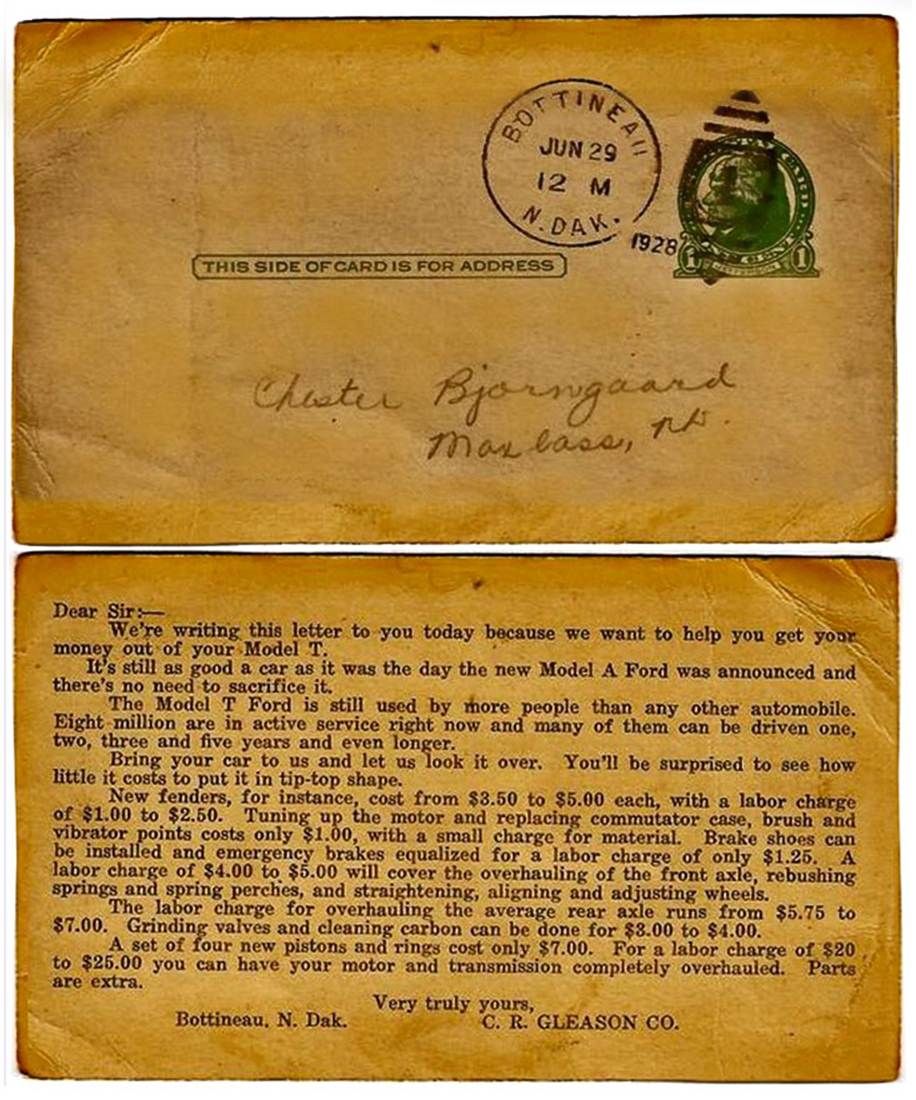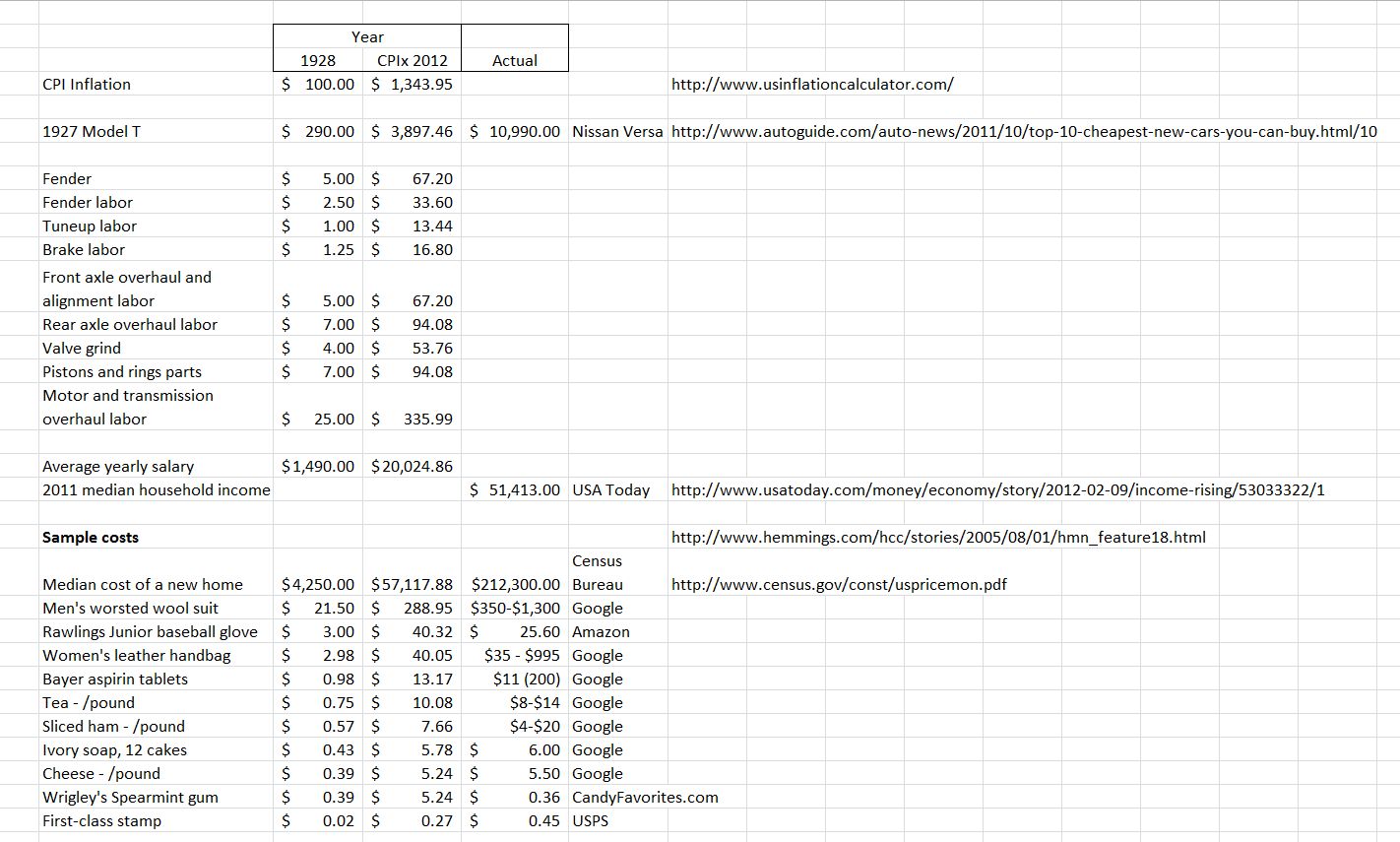My friend, Lauren Hillquist, sent me this postcard via email today:
1928 CAR REPAIR MAILER.
AUTOMOTIVE REPAIR ADVERTISEMENT IN 1928… SENT ON A PENNY POSTCARD
(click on image for full size)
He also included this text:
May 31, 1927, the last Ford Model T rolled off the assembly line. It was the first affordable automobile, due in part to the assembly line process developed by Henry Ford. It had a 2.9-liter, 20-horsepower engine and could travel at speeds up to 45 miles per hour. It had a 10-gallon fuel tank and could run on kerosene, petrol, or ethanol, but it couldn’t drive uphill if the tank was low, because there was no fuel pump; people got around this design flaw by driving up hills in reverse.
Ford believed that “the man who will use his skill and constructive imagination to see how much he can give for a dollar, instead of how little he can give for a dollar, is bound to succeed.” The Model T cost $850 in 1909, and as efficiency in production increased, the price dropped. By 1927, you could get a Model T for $290.
I thought it would be interesting to compare those prices with today’s, so I put together a quick spreadsheet comparing Consumer Price Index (CPI) inflation adjusted prices and some actual market price data.
Here’s the result (click on image for full size):
As a modern car parts comparison, I just paid $34.41 for one of three pieces that make up the tailgate hinge on a 2003 GMC pickup. All three tailgate hinge pieces totaled $56.68. That’s just for one side of the tailgate.
Note that if car part prices had risen in step with the CPI, like cheese, tea, aspirin and soap did, I could have nearly bought an entire fender for our pickup for what I paid for a tailgate hinge.
You’ll note that incomes are more than double the rate of CPI inflation. Most of that extra money apparently goes for servicing the debt on big ticket items such as homes (~4x) and cars (>2x) that have inflated in cost relatively much more than the things that drive the CPI such as foodstuffs and household supplies.
As many have noted, the recent bubble in the U.S. was centered on inflated home values, so it may be that relative to other things in the economy, there is still downward adjustment remaining in housing costs.
It is interesting that automobiles have increased in relative cost more than other consumer material goods. Given the labor component in their manufacture, some portion of that can be attributed to the ~2x higher median household income. On average, around 24 hours of labor are required to manufacture a modern automobile, less than half the time required only a couple of decades ago. Production line labor costs range from around $50 to $70 per hour, including benefits, depending on the manufacturer and the plant location.
In 1914 Henry Ford caused a sensation when he instituted $5 per day in wages and a 40 hour week. His goal was to reduce turnover, then running 300%, and he succeeded in that goal.
Since then, the amount of labor required to produce and assemble an automobile has decreased dramatically, yet the price of an automobile, and certainly its parts, have increased significantly more than other consumer goods.
Sources:
http://www.usinflationcalculator.com/
http://www.hemmings.com/hcc/stories/2005/08/01/hmn_feature18.html
http://www.census.gov/const/uspricemon.pdf
http://en.wikipedia.org/wiki/Henry_Ford
http://trade.gov/static/Motor%20Vehicles%20Industry%20Assessment%202010%20rev5.pdf
http://www.autoguide.com/auto-news/2011/10/top-10-cheapest-new-cars-you-can-buy.html/10
https://www.usps.com/ship/service-chart.htm?
http://www.candyfavorites.com/wrigley-s-spearmint-chewing-gum
http://www.usatoday.com/money/economy/story/2012-02-09/income-rising/53033322/1

